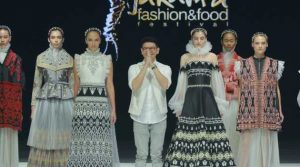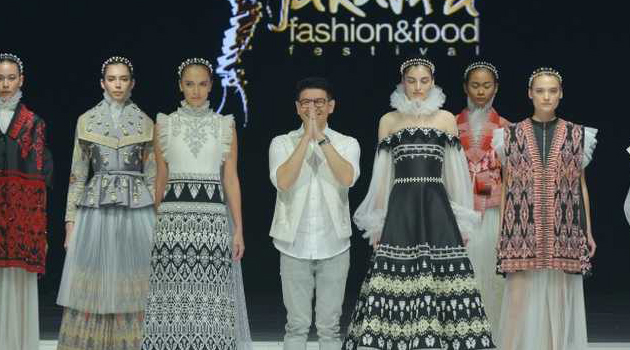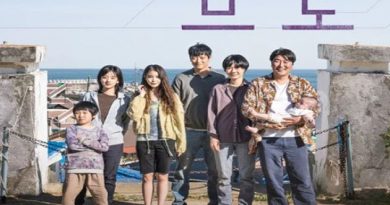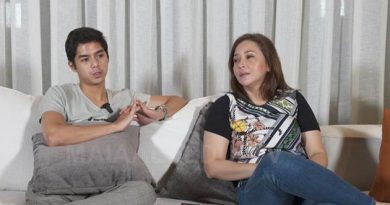Celebrating Cultural Heritage With Tenun and Batik at JFFF

Continuous innovations and collaborations are keys to the survival of any product in today’s fast-paced modern lifestyle.
The same can be said for Indonesia’s cultural heritage, batik and tenun (handwoven traditional fabrics). Without new innovations that engage the country’s youth, these prized traditional textiles might not survive the grinding wheels of modernization.
The Indonesia Batik Foundation (YBI) and the association of Indonesia’s traditional textile enthusiasts, Cita Tenun Indonesia (CTI), also realize this fact. These organizations continuously challenge young designers to come up with new innovations and fashion styles using batik and tenun.
In the recent Jakarta Fashion and Food Festival (JFFF) in Mall Kelapa Gading, North Jakarta, these organizations collaborated with indie labels and designers to present new innovations in batik and tenun in their fashion shows.
Batik Now
“For this fashion show, we’ve especially selected four young fashion designers [and labels] with creative innovations in batik,” Titik Djoyo, public relations of YBI, said before the fashion show on Tuesday (24/04). “This is in line with our organization’s mission to perpetuate batik now.”
The fashion show was themed “Batik Now.” Among the labels featured in the fashion show were “[bi]” and “Galeri Batik Jawa.”
“[bi]” was founded by six young batik lovers in Jakarta in 2005.
In the fashion show, the label showcased its new collection made of hand-stamped batik patterns in earthen hues.
“For this collection, we have innovated and used wooden blocks and ropes, instead of the usual copper stamps, to create many different organic patterns,” Haryo Upandityo, co-founder of [bi], said before the fashion show.
These new batik patterns, which resemble parched soil, marbles and mosaics, made the items in the collection look uniquely tasteful and exotic.
Galeri Batik Jawa, a cooperative of batik artisans based in Yogyakarta, presented their new batik collection, which is entirely made of natural dyes, in the fashion show.
“All the batik in this collection are dyed by using a combination of nila (Indigoferra tinctoria) leaves and mahogany bark,” said Nita Kenzo, founder of Galeri Batik Jawa.
The result of the combined natural dyes is batik with an elegant blue-black color.
The line’s cocktail dresses and evening gowns, made from these batik fabrics, looked modern and sophisticated. Leather belts, mini-skirts and bustiers also complimented some of the items in the collection.
Jalinan Lungsi dan Pakan
In the same day, Cita Tenun Indonesia also presented a fashion show at JFFF, which was themed “Jalinan Lungsi dan Pakan” (Braids of Warp and Weft).
For the fashion show, the association asked five Indonesian designers, who do not normally work with tenun, to create a special collection.
“For this show, we’ve challenged five current hit [fashion] brands in Indonesia to create a special collection by using tenuns,” said Syamsidar Isa, chairwoman of CTI. “We hope that once they’ve gotten familiar with tenun, they will continue to use them in their future collections.”
One of the designers challenged by CTI is Kleting Titis Wigati.
“I’m very excited with the challenge,” Kleting said. “I’m not really familiar with tenun. So, this project has prompted me to dig in and learn more about our cultural heritage.”
Kleting used Tenun Buton from Southeast Sulawesi for her new collection, themed “La Striscia [The Stripe], A Vibrant Currency,”
“These tenuns have beautiful, lively colors,” the designer said. “And I learned that, before the colonial era, these fabrics were actually used as the local currency in the region.”
Kleting made the tenun into simple daily wear for women. The neat tailoring, as well as cheerful colors of the fabrics, made the items stand out in the fashion show.
Fashion designer Danny Satriadi presented a collection themed “Lestari” [Sustainable] for his eponymous couture label.
The designer worked with Tenun Lombok from West Nusa Tenggara for this collection.
“This collaboration is God’s answer to my prayers,” Danny said. “I’ve seen these fabrics in CTI’s headquarters before and adored them. I had wished that one day I would get a chance to work with them.”
The designer had never used tenun for his couture label before.
For this collection, Danny combined Tenun Lombok with modern fabrics such as tulle, Shantung silk and silk organza, and made them into glamorous Edwardian-style evening dresses.
He also embellished some of the tenun’s tribal patterns with beads and crystals.
“Working with tenuns is indeed very exciting for me,” Danny said. “I think I have totally fallen in love with them. I want to explore more and work with them in my next collections.”
Courtesy : JakartaGlobe
Photo : Jakarta Globe
[social_warfare buttons=”Facebook,Pinterest,LinkedIn,Twitter,Total”]



